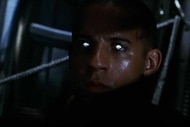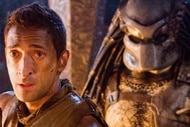The Mandalorian's Frog Lady hops on the shoulders of real-life frogs in space

The latest episode of The Mandalorian introduced viewers to one of the most bizarre, beloved characters in all of Star Wars yet: A Frog Lady. The episode, “The Passenger,” sees Mando tasked with transporting the titular passenger, an unintelligible, moderately anthropomorphic frog-person in possession of precious cargo: her eggs, which are both the only hope of continuing her line and also an extremely delicious snack for Baby Yoda.
For as strange as Star Wars' various aliens get, there's something odd about a creature who is pretty much just a frog, but in space. But, it turns out that there’s a long and storied history of frogs in space — not a long time ago in a galaxy far, far away, but here, in our world. For just about as long as there have been spacefaring rockets, there have been frogs riding aboard.
THE FIRST FROGSTRONAUTS
Frogs completed a number of missions to the heavens beginning as early as 1950, before NASA had even been founded. Both the United States and the Soviet Union were getting their space programs off the ground, and many of these early missions included animal passengers simply as a way to validate that biological organisms could survive in space at all.
In 1970, however, things got more complex. The Orbiting Frog Otolith mission launched on Nov. 9, 1970, and it carried two male bullfrogs into orbit. The frogs were equipped with electrodes surgically implanted in the inner ear, in order to monitor their function. Scientists chose bullfrogs in particular for the mission because of the similarity between their inner ear and that of a human. Additionally, their relatively small size made for a minimal launch payload, and their amphibious nature allowed them to be stowed in water during the flight, which minimized the impact of vibrations and acceleration during the journey.
The purpose of the experiment was to gain a greater understanding of the impact on the inner ear (and balance) astronauts would undergo during extended periods of weightlessness. Of course, at this stage, we had already sent human astronauts into space. November of 1970 was more than a year removed from Apollo 11 and two subsequent Apollo missions had been completed in the interim. So one might wonder at the utility of such an experiment.
It’s important to note that the mission was originally slated for 1968 but was pushed due to a series of delays. Additionally, according to NASA, a number of disorders, including disorientation, had been recorded both in human and non-human organisms in space. The OTO mission hoped to provide some insight by acutely measuring the activity of the otolith during both weightlessness and periods of artificial gravity, provided by spinning the frogs up to 50 revolutions a minute in a centrifuge.
Ultimately, the experiment was deemed a success, cataloging a number of vestibular changes that leveled out over time, suggesting that any inner ear malfunctions owing to variable gravity would acclimate. Sadly, the frogs never returned to earth. It's presumed that they croaked.
THE NEXT GENERATION
Continuing the endeavor (pun forthcoming and intended) of using frogs as a measuring stick for human activities in space, NASA once more carried out an experiment on amphibious reproduction aboard the space shuttle Endeavor in 1992. In September of that year, four African clawed frogs were launched aboard the shuttle, this time with human counterparts, and later injected with a hormone that stimulated egg production. Brace yourself for this next part.
These four female frogs were accompanied by the independent testes of male African clawed frogs that were crushed, and the extracted fluid was injected into the eggs. Traveling to space with disembodied testes, smashing them, and injecting the results into hormonally ejected eggs might be the most convoluted and bizarre instance of reproduction in all of earthly history, but it worked.
A few days later, tadpoles hatched from those eggs and appeared, aside from a few abnormalities, to be entirely normal.
On earth, frog eggs orient themselves to the ground and the uppermost portion becomes the dorsal segment of the fetus. Aboard the shuttle, the eggs had no way to orient themselves but that didn’t have a lasting impact on their development. Additionally, they did show reduced lung development, owing to the fact that tadpoles ordinarily surface in order to fill their lungs with air. Because of the microgravity environment, the tadpoles aboard Endeavor didn’t know where to surface and remained submerged. Once returned to earth, they seemed to recover without any lasting effects.
What isn’t known is what might have happened had they remained in a low gravity environment for the duration of their lives. Still, the experiment showed, at least with frogs, that fertilization and early development could happen more or less along ordinary lines.
This is good news for any future humans living aboard generation ships, bound to conceive and raise their children in space. It also bodes well for the Frog Lady and her offspring — or at least, the ones that didn't become The Child's snacks. Even if the artificial gravity of the Razor Crest were to give out, there’s no reason to expect any ill effects for her offspring. And, with the Mandalorian as her guide, there is reason to hope the future of her line is assured.
There is, as of yet, no data on the impact on frogs eggs traveling in excess of lightspeed. But, given our history of frogs as early explorers of new frontiers, if ever we develop FTL travel, we can be sure they’ll be some of the first in line. In the meantime, we’ll just have to assume the Frog Lady knows what she’s talking about.






























